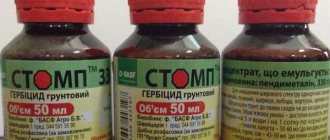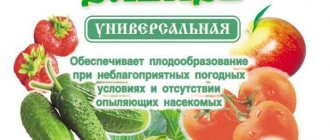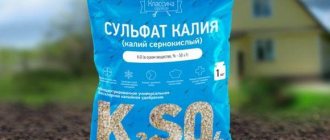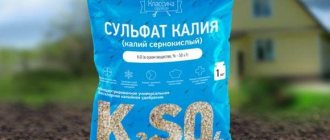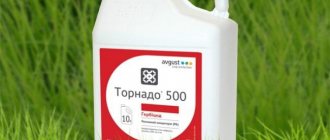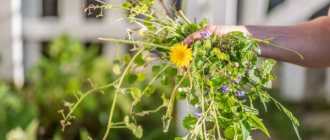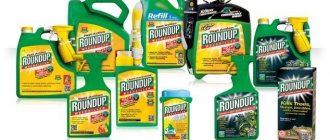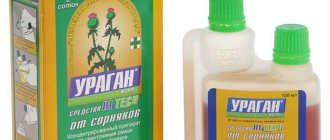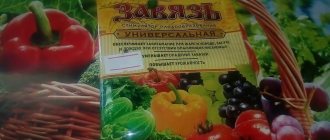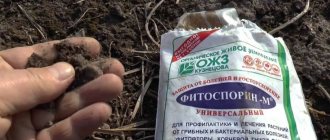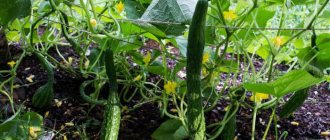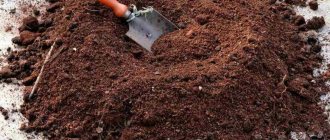Stomp herbicide and its weed control
The most important concern of every vegetable grower is weed control. Technologies in this area change every year.
New effective products are constantly being offered on the market. One of these, proven by practice and time, is the herbicide “Stomp”. Today, the product is offered in a new formulation - a microencapsulated suspension.
Advantages and disadvantages
In order to decide whether to use a product or not, it is necessary to analyze it from the positive and negative sides.
Advantages and disadvantages
does not contribute to the destruction of the ozone layer even in emergency situations;
non-toxic to humans after single use;
the suspension has a high concentration of the active substance;
affects plants selectively;
non-toxic if ingested once;
does not irritate the eyes;
resistant to biological degradation;
large time interval of application during the development of culture;
Easily washed off with water from work surfaces;
long action;
wide coverage of suppressed weeds.
irritates skin upon repeated contact;
remains active in water for a long time, toxic to the flora and fauna of water bodies;
there is no antidote.
Basic chemical indicators
The drug “Stomp” is used in combinatorial soil cultivation systems, during which chemical agents are applied sequentially at certain times, and is the basic herbicide in them. Crop protection schemes created on its basis destroy self-seeding in beds and in greenhouse conditions before sowing and planting seedlings.
Packaging for home use
Biological classification of herbicide
The group of herbicides to which Stomp belongs is the most effective. Such reagents kill the entire range of harmful herbs by chemical weeding. Here are the main characteristics of the Stomp:
- it is systemic - can be carried by plant juices;
- contact - begins to act when it comes into contact with the integument of the plant;
- selective - does not harm the sown crop;
- soil - the drug should be applied to the ground, and not to harmful self-seeding;
- pre-emergence – used before the appearance of seedlings of the cultivated species.
Active ingredient of the drug
The active reagent in Stomp, which stops the vital activity of weeds, is pendimethalin. It belongs to the class of dinitroanilines. These are yellow-orange crystals that are resistant to sunlight. Excipient – water.
Pendimethalin molecule
The herbicide is a concentrated emulsion (a mixture of two substances) containing pendimethalin in a maximum water-soluble dose of 330 g/l, packaged in ten-liter containers. An improved version is “Stomp Professional”, which contains 445 g/l of active substance enclosed in microcapsules in saline solution.
Mechanism of influence
The drug remains active in the soil for a long time due to the gradual release of the active substance from the microcapsules that make up the suspension. Weed roots, along with moisture, absorb the herbicide “Stomp” from the soil, and it suppresses the division of meristem cells, from which all plant tissues are formed. Sprouted foreign plants quickly die. Although the herbicide “Stomp” does not destroy weed seeds, due to its delayed action it destroys them after germination. The capsule shell is destroyed only upon contact with the ground.
See also
Composition and instructions for use of the herbicide Asterix, consumption rates
Read
How Stomp removes weeds
“Stomp” combines the capabilities of both a herbicide and a pesticide, that is, it destroys harmful, unwanted self-seeding, as well as insects that cause physical harm to plantings and pathogens of green spaces.
When the area is properly treated for two days, pendimethalin is evenly distributed in the seed layer of the soil, forming a barrier to weeds. It comes into operation at the moment of germination of harmful herbs.
Field after processing with “Stomp”
The active substance of the herbicide enters the seedlings of monocots through the first roots and stem, and into dicots - through the hypocotyl loop growing from the seed. The drug accumulates at the growth points of the root meristem. It forms strong compounds with the protein substance of plant tissues and stops DNA synthesis. This prevents the cells from dividing and the seedling dies.
As a result, the sprouts activated from the seeds never come to the surface. When there are already unwanted shoots on the treated area, “Stomp” will be especially effective before the development of the first pair of leaves in cereals and two true leaves in dicotyledons.
Spectrum of plant protection
“Stomp” rids cultivated plants of annual monocotyledonous weeds. It is less effective against dicotyledons; however, many of them die, especially at the germination stage. It destroys some weeds at the stage of 1-1.5 leaves, broad-leaved dicotyledons - even at the stage of two true leaves. The herbicide is powerless against strongly rooted plants and perennials.
Manufacturing company
The drug Stomp can save the owner of a plot of land from the exhausting work of weeding. It is distinguished by a wide range of crop protection, that is, it is suitable for processing several types of vegetable crops.
Stomp is a product of the German company BASF, which is considered the world market leader in the chemical industry. It produces the following products:
- Functional polymers;
- Plastics;
- Specialty chemicals;
- Plant protection products;
- Varnishes and paints, etc.
Average consumption rates for different crops
The amount of substance sprayed on crops of various crops is determined by their rates of germination and initial development.
| Culture | Consumption rate, l/ha |
| Sunflower | 3,0-4,0 |
| Corn | 3,0-4,0 |
| Onion seeds | 3,0-4,0 |
| Parsley, dill, coriander | 6,0-8,0 |
| Tomatoes, cabbage seedlings | 3,0-4,0 |
| Carrots, legumes | 3,0-3,5 |
| Potato | 5,0 |
Precautionary measures
The herbicide “Stomp” is a toxic substance, so when working with it you must follow the safety regulations:
- Since the substance can be harmful to living organisms, the sanitary zone should be observed when processing (1500 m to a reservoir, 15 m to a residential area, 50 m to people without protective equipment).
- When using the drug, protective equipment is required: hat, respirator, eye protection, latex gloves, plastic cape, rubber boots.
- The working time with the chemical should not exceed 6 hours.
- If the solution gets on the skin or mucous membranes, rinse it off immediately with running water.
- If symptoms of intoxication appear (nausea, vomiting, loss of consciousness, convulsions), you must immediately contact a medical facility.
The agricultural preparation "Stomp" is the most effective remedy against most weeds. A single application will allow you to get rid of wild plants for a long time in the garden, field and greenhouses. Following the instructions will allow you to achieve the desired result without harm to your health.
How to prepare the solution
Stomp herbicide contains 455 grams of pendimethalin per liter. To prepare a working solution for 10 ml of product, 10 liters of water are required. The sprayer tank is first filled 1/3 with water, and the calculated amount of herbicide is poured in. Stir. Add water to the full volume of the container, mix again. If the tank is large or there are breaks in work, the solution is mixed again. 200-400 liters of liquid are consumed per hectare.
Expert opinion
Zarechny Maxim Valerievich
Agronomist with 12 years of experience. Our best country expert.
Ask a Question
"Stomp Professional" is not mixed with substances based on organic solvents.
Herbicide Stomp professional
The microencapsulated suspension effectively destroys dicotyledonous and annual cereal weeds thanks to pendimethalin. A professional also has the characteristics of pesticides and herbicides, destroying weeds and harmful insects. It has a prolonged action due to its encapsulated form. The substance from the capsules is constantly released and penetrates into the soil, which is responsible for the long-lasting effect of use.
To treat an area against weeds, a single application of a microencapsulated suspension is sufficient. In the pre-emergence period, the herbicide forms a strong herbicide barrier that protects cultivated seedlings from the appearance of weeds.
Note! To prolong the herbicidal effect, fractional application of the drug to the ground is recommended.
The choice of application rate of the drug depends on the properties of the soil: on heavy and humus-rich soils, the maximum dosage is used. On light and humus-poor soils, apply the minimum rate. The approximate consumption of the finished liquid is from 200 l to 400 l per hectare.
Features of application
Pendimethalin-based herbicide should not be combined with strong acids and concentrated alkalis. The drug, acting selectively, does not harm most cultivated plants. Soybeans, peas, and sunflowers can be sown after using “Stomp Professional” with incorporation into the ground. Onions, potatoes, corn, and other grains should be planted below the herbicide application level. Both options are suitable for the seedling planting method.
Instructions for use:
- Spray the solution with the chemical.
- After 24-48 hours, embed it in the ground to a depth of 3-4 cm.
- Wet the soil by 1-2 cm. In this case, step 2 is canceled.
- Do not harvest for 60 days.
Spectrum of protective action
The application of “Stomp” is necessary in order to get rid of young monocotyledonous and dicotyledonous weeds, the seeds of which always infect planting lands.
Industrial packaging of “Stromp” in 10 liters
- The herbicide is used to control weeds in plants such as tomatoes, cabbage, corn, soybeans, potatoes, peas, carrots, onions, sunflowers, parsley and garlic.
- Plants of a one-year cycle that do not form bulbs, tubers and other overwintering underground parts are especially sensitive to treatment with the drug.
- Among the monocots that respond to pendimethalin are millet grass, annual bluegrass, bristle grass, and common broom.
- The drug eradicates the following dicotyledons: field toricot, convolvulus, medicinal fume grass, wood lice, common groundsel, small petal grass, quinoa, garden purslane, field violet, acorn grass, black nightshade, chamomile, purple marigold, white pigweed, tenacious bedstraw, and pickleweed.
Bluegrass annual
- “Stomp” has a lesser, but also destructive effect on knotweed, white mustard, stinging nettle, leftwort, wild radish and on such biennials as shepherd’s purse and field grass.
According to research, the effect of a herbicide on a plant is less, the more lipids there are in its seeds.
Security measures
Direct contact with the Stomp herbicide should be avoided. Recommended:
- Wear special gloves that are resistant to chemicals.
- Cover the body with clothing as much as possible.
- Wash contaminated clothing immediately.
- Do not inhale fumes or splashes.
- In case of contact with skin, wash the area with running water and soap.
- Eyes should be open while rinsing with plenty of water. Perform the procedure for 15 minutes. Contact an ophthalmologist.
- After swallowing, rinse your mouth immediately and drink 300 ml of water. Go to the doctor.
- When working with poison for a long time or in high concentrations, wear a respirator.
- Wear safety glasses.
- While spraying, you should not eat, drink, smoke or talk.
- After finishing work or before lunch, wash your hands and face thoroughly.
See also
Instructions and method of use of the herbicide Sprut Extra, consumption rate
Read
STOMP, CE (330g/l)
| Company manufacturer | Processed crop | Packaging l/kg | Consumption rate kg, l/ha | Price |
| BASF | Potatoes, sunflower | 10l | 3,0-6,0 | to know |
Preparative form: emulsion concentrate
(CE)
Active ingredient: pendimethalin
Active ingredient concentration: 330 g/l
Chemical class of active substance: dinitroanilines
Packaging: 10l canister
Highly effective pre-emergence herbicide for the control of a wide range of monocotyledonous and dicotyledonous weeds in vegetable and sunflower crops
- long lasting protective effect
- forms a reliable herbicidal screen
- safe for the treated crop and subsequent crops in crop rotation
- Resistant to degradation when exposed to sunlight
- does not require immediate sealing and mechanical treatment of row spacing
Pendimethalin, the active ingredient of the herbicide STOMP®, has a special mechanism of action that is completely different from other groups of herbicides. It blocks the central process of weed growth: cell division. The weeds immediately stop growing, wither and finally die.
This effect occurs both through direct contact with growing leaf cells, and for a long time after treatment due to part of the active substance, which bypasses the leaves and reaches the soil. When the root cells of germinating or already germinated weeds come into contact with the active substance, they immediately lose their ability to divide.
How to increase the effectiveness of the drug
The herbicide “Stomp” exhibits the greatest activity at temperatures above 8 °C and below 25 °C. Its effect is enhanced by moderately moist soil. The timing of the treatments is important: the smaller the sprouts, the more certain the death of the weeds. Organic matter in the soil absorbs some of the substance. Therefore, before spraying, plant residues are buried to a depth of less than 20 cm.
Before applying a pesticide, check the weather forecast so as not to do the work before heavy rains.
It is necessary to think through the application rates of the product, adjusted for the age of the weeds and the type of soil. This will reduce the likelihood of the emergence of vegetation resistant to the herbicide “Stomp”.
Composition and active substance
"Stomp" refers to herbicide systemic pesticides for pre-sowing treatments. The drug penetrates the tissues and, through the movement of juices, spreads throughout the weed’s body, starting to work from the moment it hits any part of the plant.
The active component of Stomp is the herbicide pendimethalin, which is a dinitroaniline ammonia derivative. These substances effectively suppress monocotyledons and dicotyledons; perennial weeds are less sensitive to the chemical. The active substance accumulates in cells and stops mitosis, blocking the process of protein synthesis. As a result of a chemical reaction, the root hairs of weed seedlings dry out, adequate nutrition is disrupted, and death occurs after 3 days.
The herbicide works selectively on a certain type of wild plants; it is not dangerous for cultivated plantings. 2 weeks after application, pendimethalin evenly covers the fertile soil layer, forming a protective barrier against weeds.
Targets
The general features of the action of Stomp are also superimposed on the specific sensitivity of different plants to pendimethalin. As a result, on soils suitable for this preparation (see above), the use of the Stomp herbicide will certainly suppress the development of the following weeds:
- Veronica;
- Field forget-me-nots;
- bedstraw;
- Scilla annual;
- Chamomile officinalis.
In favorable climatic conditions (also see above), except for those indicated, manual weeding will not be required:
- Amaranths (amaranths, except foxtail);
- Veronica (species);
- Knotweeds rough and bindweed;
- Field mustard;
- Barnyard grass (species);
- Chickweed average;
- Common groundsel;
- Quinoa is garden and spreading;
- White pigweed;
- Common broom;
- woodlouse;
Finally, against the trail. weed herbicide Stomp will be quite effective only in wet years on light humus-rich soils:
- Galinsoga parviflora;
- Bird's knotweed;
- White mustard;
- Fumerica officinalis;
- Levcoyus jaundice;
- Ropeman of Theophrastus;
- Stinging nettle;
- Foxtail (foxtail amaranth);
- Canadian small petal;
- Dandelion;
- Nightshade black;
- Shepherd's Purse;
- Cleavers;
- Crabgrass (species);
- Field jar.
Release forms
The registration period in the Russian Federation for the drug Stomp KE (emulsion concentrate) with an active ingredient content of 33% (330 g/l) expired in 2022. Currently, until 2022, Stomp Professional MKS (microencapsulated suspension) with an active ingredient content of 45 is approved for use in private household plots until 2022 .5% (455 g/l). Stomp Professional MKS is much more effective and safer than Stomp CE and its action is less dependent on weather and soil conditions, because microcapsules open more actively in the most suitable external conditions for the drug, which are also the most favorable for the development of weeds. For them, the Stomp Professional is something like a saboteur, patiently waiting in ambush to find the best moment to attack. Further in this article, all recommendations for use refer to the drug Stomp Professional.
Note: in Bulgaria Stomp Professional is produced under the name Stomp Aqua, see video:
Video: about Stomp Aqua
Ways to influence herbicides on weeds ↑
Based on their effect on vegetation, herbicides are divided into 2 groups:
- continuous action (all green plants killed) that were treated,
- selective or selective action (drugs have a detrimental effect only on certain types of green plants). This group of herbicides is used in agriculture to prepare heavily contaminated soil with weeds.
According to the method of action on weeds, they are also divided into 2 groups:
- contact, cause a locally penetrating effect leading to the destruction of the plant,
- systemic ones, getting on the surface of the plant, penetrate inside and, with a current of liquid, are carried to all organs (including the root system) of the plant, causing its death.
As a rule, selective, systemic herbicides are used on vegetable crops when preparing the soil for sowing or planting seedlings. Such chemicals include the herbicide Stomp.
